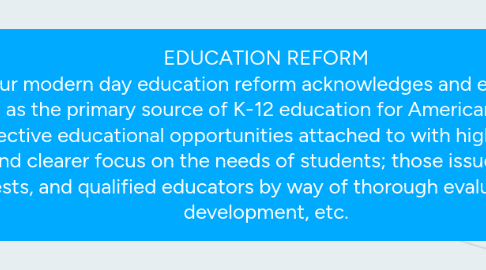EDUCATION REFORM Our modern day education reform acknowledges and encourages public education as the primary source of K-12 education for American youth implementing toward more effective educational opportunities attached to with higher standards, greater achievement, and clearer focus on the needs of students; those issues as student health, standardized tests, and qualified educators by way of thorough evaluation & professional development, etc.
von Victor Bernard

1. Standardized Tests: Standardized tests are norm-referenced tests that compare individual scores to others at the same grade level. Standardized tests include math content, verbal or spatial content, and content requiring prior knowledge of a subject all of which are questionable as to whether students really learn these skills in school or already display this knowledge. Standardized tests provide comparison among and across different groups in order to make decisions to help students. Many teachers use the data from test results to drive their instruction, but most teachers agree that the results from a standardized test are only one part of their overall assessment of students. (Popham, 2005)
2. Quality Educators by Evaluation: Who should we blame? This question has been a continuing debate among politicians as they want to evaluate and blame the educator. Therefore, such evaluation methods are necessary point out teachers who do not reflect quality teaching skills when it comes to holding the educator at such a high level for student achievement. The two main purposes of teacher evaluation, assuring teacher quality and facilitating improvement in teachers’ work, will best be achieved when teachers and their organizations claim the responsibility for developing and implementing methods for assessing teacher performance that respect the complexity and depth of their professional knowledge and practice (Kleinhenz & Ingvarson, 2004) .
3. Student Health: Obesity has reached epidemic proportions in the U.S., and the same poor eating habits that led to the obesity problem may also be contributing to lower student achievement. Obesity also increases a student’s risk for other conditions, like diabetes and high blood pressure, which could result in higher absenteeism and more academic issues. U.S. Department of Agriculture released new guidelines in 2012 to boost the nutritional quality of the meals students get at school. Exercise programs are also coming to schools across the country to promote more physical activity among students of all ages. (USDA, 2012).
4. Professional Development: Teachers are responsible for finding ways to educate all children and it is a teacher’s duty to participate in professional development activities that foster this responsibility. Practices such as differentiated instruction, data driven instruction and identifying areas of weakness in students are crucial to developing the quality of classroom teachers. (Gallagher, 2002).


